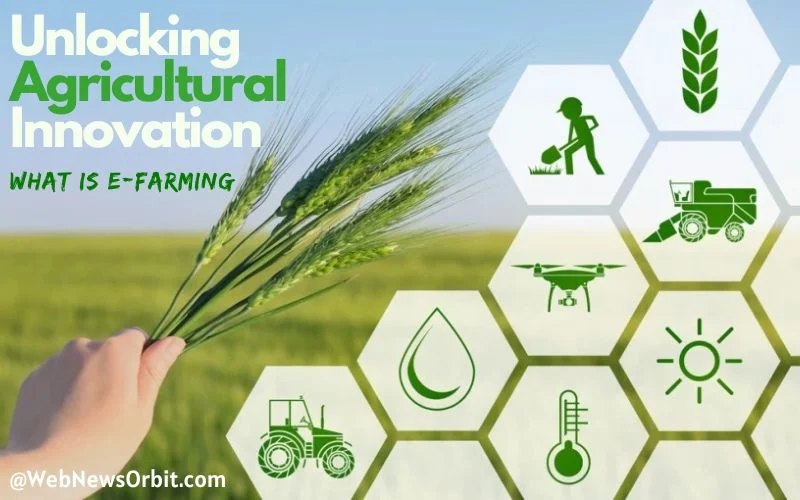Unlocking Agricultural Innovation: What Is e-Farming? In a world characterized by rapid technological advances all aspects of life on earth is changing. Agriculture, the foundation of civilisation, isn't an exception.
{getToc} $title={Table of Contents}
This article explores the rapidly evolving world of e-Farming by defining its definition, the components advantages, challenges and its global acceptance.
1. What Is e-Farming
e-Farming is a combination of cutting-edge technology with the traditional methods of farming, are changing the landscape of agriculture.
2. Understanding e-Farming
2.1 Definition and Concept of e-Farming
e-Farming, also known as Electronic Farming, refers to the incorporation of digital technology in agricultural processes to increase efficiency as well as productivity and sustainability.
It includes a variety of practices that utilize sensors, data and automation to improve different farming processes.
2.2 Evolution of Agriculture and Technology
To fully appreciate the importance of e-Farming It is essential to understand the evolution of agriculture as well as technology. From primitive tools to the latest equipment farming has always closely linked to technological advancements.
e-Farming is the most recent phase in this journey which is where the digital tools are driving innovations in farming practices.
3. Key Components of e-Farming
3.1 Precision Agriculture
Precision Agriculture involves using data-driven insights to modify farming practices to the variations in soil, weather and the conditions of the crop. This method maximizes the use of resources such as pesticides and fertilizers, and reduces loss.
3.2 Agricultural Drones
Drones that are used for agricultural purposes with cameras and sensors collect real-time information, allowing farmers to track the health of their crops as well as detect pests and evaluate the need for irrigation. Drones have revolutionized field scouting. They provide a bird's eye view of the farm.
3.3 Smart Irrigation Systems
e-Farming introduces smart irrigation systems that can adjust the water flow according to weather forecasts and soil levels of moisture. These systems help conserve water and reduce over-irrigation thus promoting sustainable use of water.
3.4 Data Analytics and Predictive Modeling
e-Farming utilizes predictive models and data analytics to predict crop yield diseases, outbreaks of disease, and market developments. This helps farmers make informed choices and improve their strategies for production.
4. Benefits of e-Farming
4.1 Increased Efficiency and Productivity
e-Farming improves efficiency, cutting down on the need for manual labor and time. This efficiency results in increased productivity, allowing farmers to manage large areas of land more effectively.
4.2 Resource Conservation and Sustainability
The exact application of resources in e-Farming reduces the amount of waste, while also conserving water, fertilizers, as well as energy. This sustainability-driven approach aligns with global efforts to mitigate agricultural's impact on the environment.
4.3 Enhanced Crop Quality and Yield
Through monitoring and adjusting crop conditions in real-time, e-Farming contributes to improved yields and better quality of the crop. This means greater economic benefits for farmers.
4.4 Improved Decision-Making
e-Farming gives farmers data-based insight, allowing farmers to take timely and correct decisions. This is particularly important in decreasing the risk of unpredictability in weather conditions and market fluctuations.
5. e-Farming Challenges and Considerations
5.1 Initial Investment and Access
Although e-Farming has many advantages but it is a costly initial purchase of technology, and education is a challenge even for farmers on a small scale. Connecting the digital divide and ensuring accessibility to technology is a major challenge.
5.2 Data Privacy and Security
The sharing and collection of information from farms raises questions about security and privacy of data. Farmers must be assured that their private information is secure from unauthorised use or access.
5.3 Digital Divide and Inclusivity
The adoption of e-Farming varies from region to region and is often due to differences in the digital infrastructure and educational. The effort is needed to ensure that the e-Farming solution is accessible to all farmers, regardless their location or available resources.
6. e-Farming Adoption Around the World
6.1 e-Farming Success Stories
Many regions of the world have adopted e-Farming with awe-inspiring results. From the highly-technological farms in the Netherlands to cutting-edge practices in India as well as Kenya, e-Farming is yielding positive results.
6.2 Government Initiatives and Support
Governments are beginning to recognize the potential of e-Farming, and are offering incentives as well as subsidies and educational programs to encourage the adoption of e-Farming. These initiatives play an essential role in driving technological innovation in the field of agriculture.
7. Future Prospects and Innovations
7.1 Artificial Intelligence in e-Farming
Artificial Intelligence holds immense promise for e-Farming. It can provide sophisticated data analytics, automatic decision making and even recommendations for crop-specific treatments.
7.2 Blockchain Technology for Traceability
Blockchain's transparency and tamper-proof design will improve traceability of food by allowing consumers to trace the path of their produce all the way from field to plate.
7.3 Climate-Resilient e-Farming Solutions
Since climate change has a direct impact on agricultural production, e-Farming could provide innovative solutions, like drought-resistant plants and real-time temperature monitoring, to be able to adapt to the changing weather conditions.
Conclusion
e-Farming sits at the crossroads of tradition and technology, providing the possibility of sustainable efficient, effective, and profitable farming.
As technology continues to advance, e-Farming has the potential to transform how we manage the land, providing food for communities while ensuring a robust future for agriculture.
Through addressing issues and engaging in the latest technology, farmers and other stakeholders can leverage the power of e-Farming to guarantee food security and a vibrant agriculture sector for the generations to come.
If you want to stay updated like this always, then definitely follow and subscribe to Web News Orbit. If you want information on any topic then do not forget to write in the comment.

